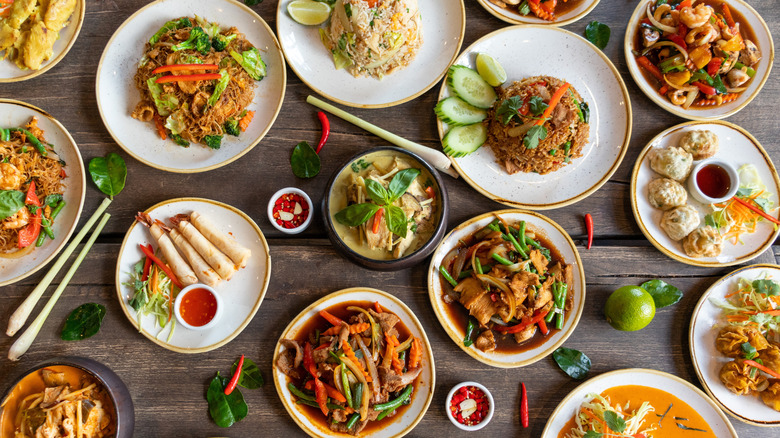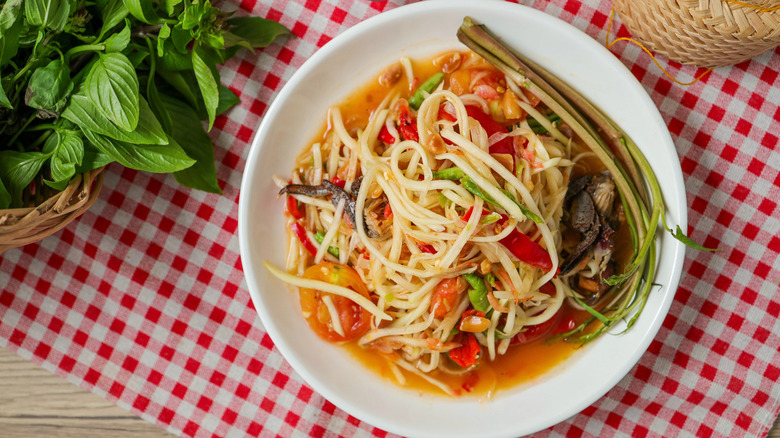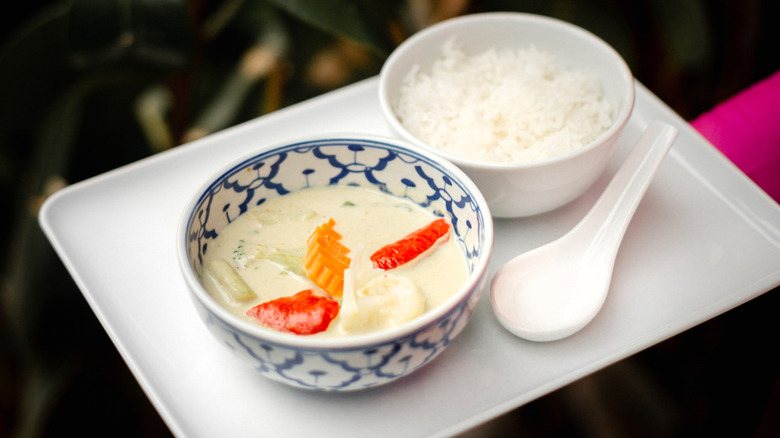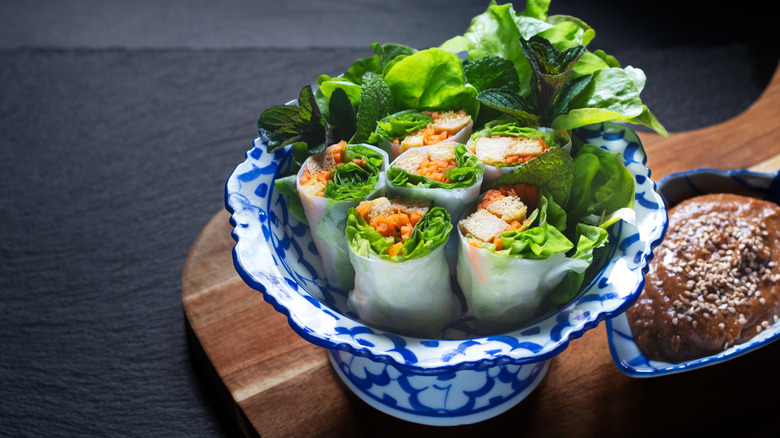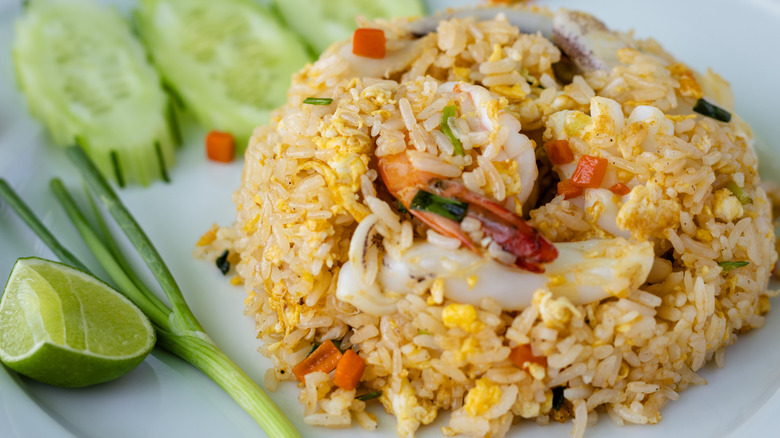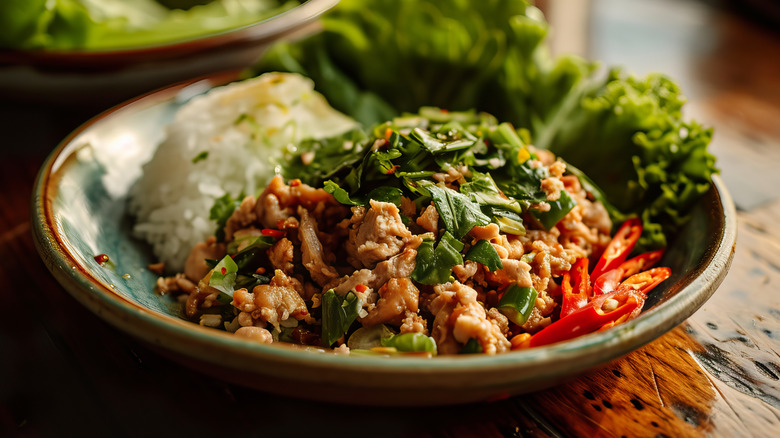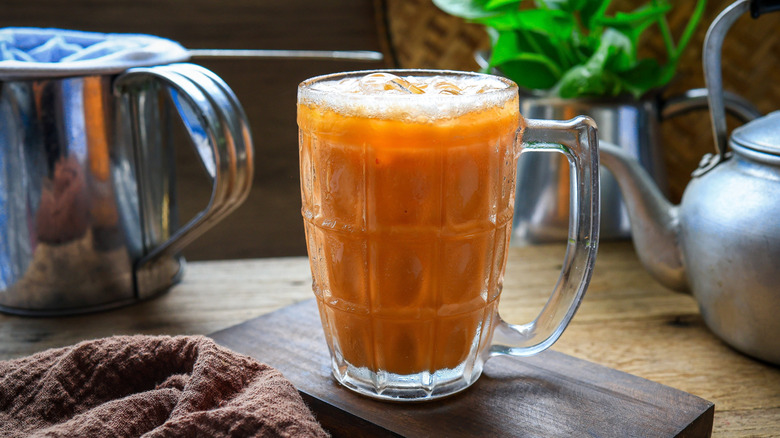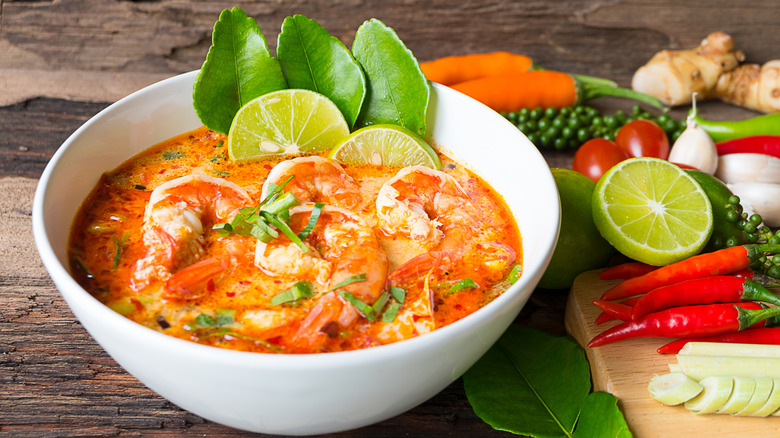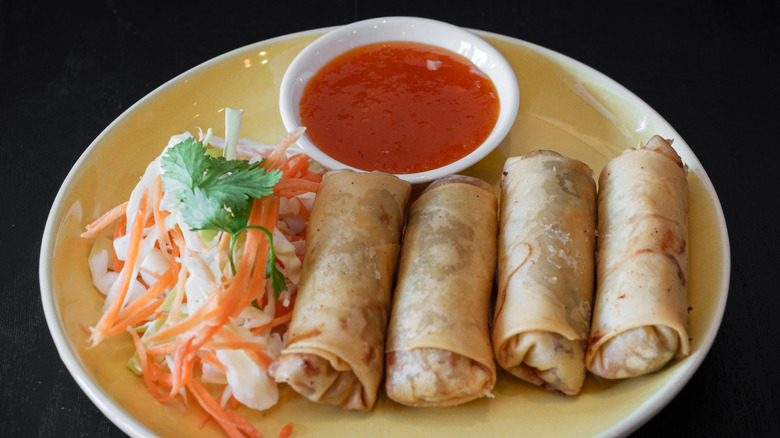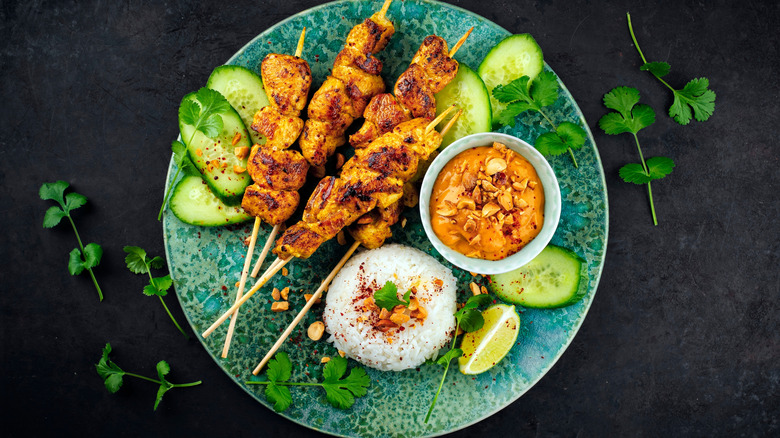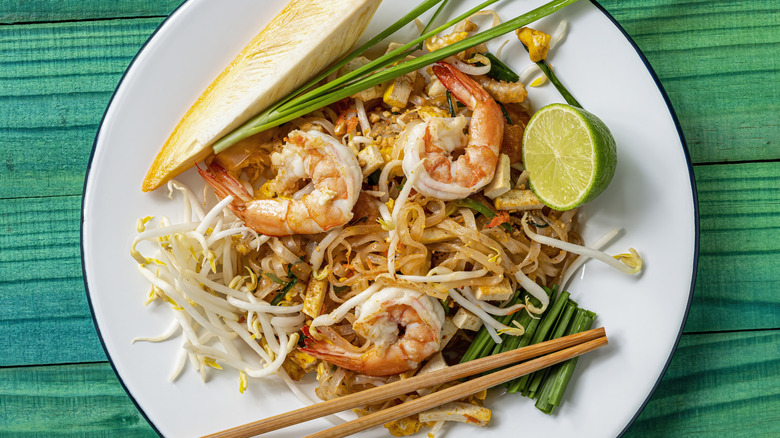5 Unhealthiest And 5 Healthiest Things To Order At A Thai Restaurant
There's no denying that Thai cuisine is incredibly layered and diverse. The different regions in Thailand serve up some of the most outrageously flavorful and delicious dishes, packed with bold ingredients and unexpected combinations. With its exquisite balance of sweet, salty, sour, and spicy bites, it's no wonder Thai food ranks high on the list of the country's favorite cuisines. But not everything you eat at a Thai restaurant is necessarily "good for you." If you are on a diet or aiming to eat clean, we hate to break it to you, but there are a couple of definite no-nos from your regular roster of favorites.
From coconut-laden curries to zingy protein-packed salads, knowing what to order and what to skip can make all the difference to your health. There's a lot of conflicting information online, so to avoid the overwhelm, here's a handy-dandy list for your next Thai night out. We promise, with a little care and knowledge, you can enjoy spicy Thai food without derailing your nutrition goals — so grab your chopsticks and dig in.
Healthy: Raw papaya salad
Salad is done differently in Thailand. No limp lettuce and soggy tomatoes drenched with calorific dressings. Instead, think of the freshest ingredients combined with sweet, savory, salty, and spicy flavors. Among the many salads you can order at a Thai restaurant, we suggest you hone in on what CNN Travel calls one of the world's best 50 foods – som tum, or raw papaya salad.
Also known as green papaya salad, this vibrant plate is packed with fiber, vitamins, and antioxidants, thanks to the inclusion of ingredients like grated raw papaya, red chilies, peanuts, lime juice, tomatoes, string beans, garlic, and dried shrimp. There are several versions of som tum found across Thailand, and depending on the region or the specialty of the restaurant you're dining at, you might encounter variations featuring fermented fish sauce, crab, and even Thai aubergines.
Enjoy som tum as a starter, or relish it as a sharing dish along with a small portion of sticky rice. This vegetable-packed dish can lean a little sweet if the chef is heavy-handed with the palm sugar, but overall, it makes for an excellent healthy choice when eating out. Papaya also acts as a natural digestive aid and may help reduce the risk of diabetes and heart disease, so go ahead and heap that plate full. At home, you can make this Thai salad with green cabbage if you can't get hold of papaya.
Unhealthy: Red or green Thai curry
Many of the curries and soups from Thailand share a common (not so secret) ingredient: coconut milk. Made from the creamy flesh of the coconut, coconut milk is added to dishes like massaman, red, and green curries, and soups like tom kha gai to add a lush texture and taste. Real coconut milk is thick with a hint of natural sweetness and contains compounds and MCTs (medium-chain triglycerides) that are said to have anti-inflammatory and antioxidant effects. On the flip side, however, full-fat canned coconut milk is high in calories and saturated fat (which can lead to high cholesterol if eaten in excess), so it may not be ideal for people looking to lose weight or reduce their fat intake.
Thai curries usually have some form of added protein. Fish and prawns are healthier choices as compared to fried chicken or pork. That said, if you are going to have a curry, opt for one packed with vegetables, or ask for them to be added along with your choice of protein to up the nutritional content.
The fact that curries are usually served with white rice doesn't help the case, either. Rice can cause spikes in blood sugar levels (and the resulting crash in insulin and energy levels after eating). To optimize your Thai meal, serve up a smaller portion of rice (or swap for cauliflower or black rice), limit the curry, and balance the rest of your plate with vegetables and non-fried sides.
Healthy: Summer rolls
Also known as fresh spring rolls, summer rolls are a staple across Asia in various forms. In Thailand, this rice paper roll is usually packed with crunchy raw veggies, rice noodles, herbs, and some form of protein such as steamed prawns or sautéed beef, or chicken. When ordering summer rolls at a Thai restaurant, ask for yours with veggies and a healther protein like salmon or tofu, instead of ones with fried chicken or battered fish. Leaving out or reducing the rice noodles will also lower the overall calorie count. Similarly, avoid or limit the salty, sweet, and fatty peanut dipping sauces.
The herbs and vegetables inside summer rolls are great sources of fiber, vitamins, and antioxidants. They aid digestion, support heart health, and may lower the risk of diabetes and obesity. The rice paper that the rolls are made of is naturally gluten-free and low in calories, and as long as it's not fried (becoming the tasty but more oily egg roll), summer rolls are an awesome healthy swap while dining out.
Unhealthy: Thai fried rice
It's Friday night, and you head to your favorite Thai place for some curry and fried rice. Harmless, right? But all is not quite as it seems. You may want to rethink those choices if it's a healthy meal you are aiming for. Let's break it down for you.
First off, Thai fried rice is typically made with jasmine rice, a type of white rice. Cold, pre-cooked rice gets tossed into a hot, oily wok, and while the sizzle may sound glorious, the result isn't that kind to your health. White rice is notorious for causing blood sugar spikes and that familiar post-meal sluggishness. Then comes the sauces that make the rice a savory, flavor bomb that everyone loves. Soy, oyster, chili, and ever-versatile fish sauce are delicious but extremely high in sodium. And high sodium can mean water retention, bloating, and increased blood pressure.
As for veggies? Most Thai fried rice versions come with a few token carrots or beans. Instead, the dish is usually served with fried chicken, beef, or pork, which adds even more fat and calories. And let's not even get started on those irresistible deep-fried onions and garlic toppings. In short, Thai fried rice is not your friend if you're trying to eat clean. A smarter swap? Go for steamed rice with veggies and stir-fries to boost your protein and fiber content without the added grease.
Healthy: Larb
Uh-no, not another salad. Obviously, if it's a "salad," it's going to probably be boring if it's healthy, right? Well, we beg to differ. We can assure you that larb is unlike any other salad you have ever had. It's packed with fragrant herbs like cilantro, mint, and basil (all excellent sources of vitamins and heart-healthy nutrients). It also contains red chilis, which not only bring flavor but are also considered natural metabolism boosters.
Larb (or laab) is a traditional, protein-rich dish from the Isaan region of northern Thailand. It's often made with minced chicken or pork, though you will find versions of this salad throughout the country, with slight tweaks in ingredients or prep. Traditionally, a level of crunch is added by roasting rice and grinding it to a rough powder and tossing it in the salad. While this does increase the calories, it is a relatively minor (and gluten-free) addition to an overwhelmingly healthy meal choice.
Enjoy larb with crispy lettuce cups for an amazing low-carb meal, or along with a small portion of steamed rice (balance, after all, is the name of the game). Some restaurants also offer larb with plant-based options, making it a versatile and delicious meat-free option.
Unhealthy: Thai iced tea
While many Americans love an iced frappe or Frappuccino, Thai people have their iced teas — but these are not the average lightly sweetened teas you might be used to. Thai iced teas are absolute sugar bombs. Typically made with strong black tea, these drinks are blended with a huge amount of sweetened condensed milk and sugar. This results in a creamy, delicious sweet indulgence that could almost count as a dessert, since just one serving of the tea can provide half the daily recommended amount of sugar.
Now, tea on its own has a fair amount of nutritional benefits. It's been linked to improve cardiovascular and metabolic health, as well as a calming effect on the nervous system. But once it's loaded with sweeteners, those benefits are drowned in a pool of excess calories. In addition, the high levels of sugar can cause blood sugar spikes and crashes, which can ultimately lead weight gain and potentially increase the risk of diabetes. Sure, on a hot day, it's a lifesaver, but a serving can easily bump up your calorie intake.
Ideally, when dining at a Thai restaurant, sip on regular iced blended teas. Better yet, sip on a relaxing cup of hot jasmine or green tea instead of the milky blends for an added antioxidant boost.
Healthy: Tom yum
Open some Reddit or Quora threads about Thai food, and you could be bombarded with misinformation about what is healthy and what is not. From self-proclaimed experts who insist that Asian food with its high spice levels and smaller portions automatically means healthy, to others who view anything unfamiliar with suspicion, it's no wonder people are confused.
Let's clear this up once and for all. When it comes to nutrition, the same basic rules apply, no matter the cuisine. Dishes that are high in fat and simple carbohydrates generally fall on the unhealthy side, while those packed with fresh vegetables and high protein tend to be healthier. Take soups in a Thai restaurant, for example. Some like tom yum are made with flavorful broths packed with vegetables, herbs, and spices that are low in calories but high on the satisfaction scale. Others like tom kha contain coconut milk and palm sugar that can push up the fat and calorie count.
Soups like tom yum can have fewer than 100 calories per bowl. With protein-rich ingredients like shrimp and tofu and vegetables such as mushrooms, tomatoes, and spices, it's basically a hug in a mug. As a bonus, the lemongrass found in Thai cuisine, and especially Thai soups, is also a great add-on to a healthy diet. It has been known to help calm anxiety and lower blood pressure.
Unhealthy: Fried food
When choosing between healthy and unhealthy menu options, some rules are glaringly obvious. For example, stay away from heavy, sweetened drinks or mind the butter. At Thai restaurants, it should be understood that the more fried the food, the less healthy it is.
And make no mistake, the Thais love to fry. A walk through a food street or market in Thailand, and you will find fried seafood, meats, fruit, appetizers, and even deep-fried vegetables. Nothing is ignored. But while the result might be light and crisp rather than greasy, no amount of expertise can shy away from the fact that fried food tends to be more unhealthy. While known for their bold flavors, Thai snacks such as deep-fried spring rolls, fried fish, and prawns are crunchy and tasty. But they are also loaded with saturated fats, which are linked to high cholesterol and increased risk of heart disease.
Dessert at a Thai restaurant can be tricky, too. Deep-fried bananas coated in coconut batter may sound like a fruity indulgence, but don't be fooled: It's one of the most oil-laden, sugar-packed options out there. Instead, try a fruit sorbet or just a plate of fresh fruit if available. These still satisfy a sweet tooth, but are far lower in fat and easier on your digestion.
Healthy: Chicken satay
When it comes to dining out at a Thai restaurant, chicken satay is one of the better choices you can make, especially if you're trying to eat clean without sacrificing flavor. These juicy, smoky skewers of marinated meat make for a lean, high-protein option that can keep you full and satisfied for longer.
The chicken is typically marinated overnight in a flavorful mix of turmeric, salt, a touch of palm sugar, coconut milk, and bay leaf. While this does add a bit of fat and sodium, it's minimal compared to deep-fried or heavily sauced dishes. Ultimately, this protein-rich dish can help to curb cravings and benefit long-term weight loss goals. Pair this with a side of stir-fried or steamed veggies, or the famous papaya salad or tom yum soup, and you have a nutritionally packed food that ticks all boxes.
There is a caveat, though: The dipping sauce needs to be treated with caution. Peanut sauce, usually served with satay, is the perfect creamy counterpoint to the charred smokiness of the meat. But it's also high in calories, sugar, and sodium. Either lightly drizzle it on top of your skewers or dip very lightly for the least unhealthy effect. In short, chicken satay can be both flavorful and diet-friendly with just a few small tweaks.
Unhealthy: Pad Thai
For our final entry, we tackle many people's favorite takeout meal — pad Thai. But there's a problem. On one side, some swear by the healthy, balanced nature of this yummy noodle dish. On the other side, some decry its nutritional value and say it should only be eaten occasionally. So what's the truth?
Pad Thai, especially restaurant-made ones, generally use refined rice noodles, which are high in carbohydrates and low in fiber — an unhealthy combination as it is. The noodles are then stir-fried in oil and tossed in a mix of high-sodium sauces and sugar. By now, we know that these contribute to bloating, high blood pressure, and long-term heart risks. Many pad Thai restaurant portions are fit for two people and can clock in at over 800 calories, often with minimal vegetables and fried proteins, making it a possibly unhealthy option.
But let's look at it from the other side as well (because we are nothing but fair). Despite its reputation, pad Thai can be healthy. The eggs, chicken, shrimp, and tofu typically added to the dish are excellent sources of lean protein and offer vitamins and antioxidants to your daily diet. If you do dine out and are craving pad Thai, perhaps request an extra helping of vegetables and leaner protein, and half your portion size to transform it into a more balanced meal.
